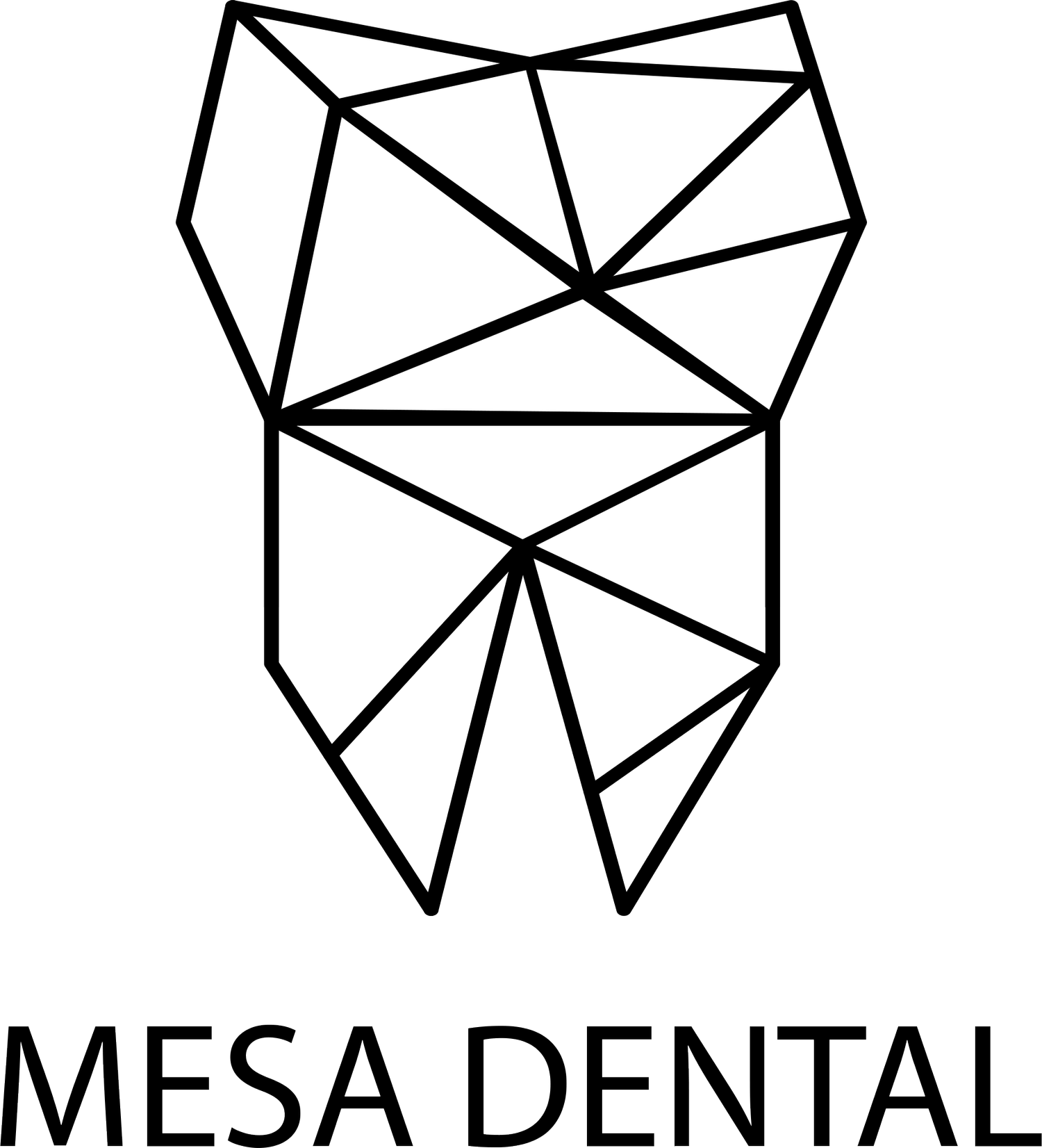RESTORATIVE & AESTHETIC DENTISTRY
The team at Mesa Dental provides an array of restorative dental services combined with top-notch customer service. If you or anyone in your family is in need of wisdom teeth removal, dental bridges, root canals, gum disease treatment, gum grafting, inlays and onlays, dental crowns or dental fillings, we are here for you.
DENTAL BONDING
Dental bonding is one of the easiest, least expensive cosmetic dentistry procedures in the dentist’s arsenal. Your dentist can shape and polish the composite resin used in bonding to seamlessly match your adjacent teeth. Most often, a dentist uses bonding for cosmetic purposes to improve the look of a discolored or damaged tooth. Bonding can also be used to close gaps between teeth, make teeth appear longer or change their overall shape and color.
Sometimes we use bonding as a cosmetic alternative to amalgam fillings or to protect the exposed portion of a tooth’s root, such as when gums recede. No preparation is required for bonding, and anesthesia is typically unnecessary unless we use bonding resin to fill a decayed tooth where there might be some discomfort involved for the patient.
ABOUT DENTAL BRIDGES
Like dental crowns, dental bridges are fixed prosthetic devices that your dentist or a prosthodontist cements onto existing teeth. We commonly use bridges for patients who are missing one or more teeth. We create precision-crafted bridges and cement them onto adjacent natural teeth or onto dental implants surrounding the space left by the lost or missing tooth or teeth. The typical dental bridge consists of two dental crowns surrounding a false tooth, which is called a pontic, in the middle. Our dentist affixes the two dental crowns onto the teeth directly adjacent to the space left by the missing tooth, thus creating a proper bite and restored chewing function. Some bridges are designed to replace two missing teeth in the same area instead of one.
If you are missing more than two teeth, dental implants, dentures or partial dentures may offer better solutions.
THE BENEFITS OF BRIDGES
In addition to replacing missing teeth, bridges can be used to improve your appearance, tooth shape, alignment, and overall bite, also known as dental occlusion. The gaps left in your mouth by missing teeth can cause your remaining teeth to shift, which can ruin your bite mechanics and cause other dental problems. Bridges and crowns can help prevent shifting teeth and poor bite mechanics. The false teeth or pontics used in dental bridges can be made from metal alloys, gold, porcelain or a combination of these materials. Bridges can be supported either by natural teeth or by dental implants. Bridges can:
Restore your smile
Restore the ability to properly chew and speak
Maintain the shape of your face
Distribute the forces in your bite properly by replacing missing teeth
Prevent remaining teeth from drifting out of position
WHAT ARE THE DIFFERENT TYPES OF DENTAL BRIDGES?
There are three main types of bridges:
Traditional bridges include a crown to cover the tooth or implant on each side of a missing tooth, with a pontic in between. These bridges are most common and are made of porcelain fused over metal or ceramic material.
Cantilevered bridges, which are rarely used anymore, were used for patients who had adjacent teeth on only one side of the missing tooth or teeth. This type of bridge is not recommended for placement in the back of the mouth where it can put too much force on adjacent teeth and cause damage to them.
Maryland bonded bridges (also called resin-bonded bridges or Maryland bridges) are made of porcelain, porcelain fused over metal or plastic teeth and gums supported by a metal or porcelain framework.
HOW ARE DENTAL BRIDGES APPLIED
The process involves preparing your adjacent teeth to receive the bridge. These adjacent teeth are called abutment teeth. Tooth preparation involves reshaping these teeth by removing a bit of enamel to make room for a crown to be placed without affecting your bite. Your dentist then takes impressions of your teeth. These impressions lead to the creation of a 3D model from which the bridge, including pontic and crowns, can be fabricated in a dental lab. Your dentist will make a temporary bridge to protect your exposed teeth while the permanent bridge is being made.
You will need a second visit so your temporary bridge can be removed and your new bridge can be checked and adjusted to achieve a proper fit and bite. Additional visits may be necessary to adjust the fit of your new bridge. This varies according to each patient’s needs. If your bridge is a fixed traditional bridge, your dentist may cement it in place temporarily for a couple of weeks to ensure proper fit. Once we achieve proper fit, we cement the new bridge permanently in place.
Dental bridges can last from five years up to 20 years with proper care and oral hygiene.
HOW IS COSMETIC BONDING DONE?
Your dentist uses a dental shade guide to choose the composite resin color that matches your tooth color most closely. Once your dentist has chosen the color, he or she will slightly abrade, or etch, the surface of the tooth to roughen it. The tooth will be coated lightly with a conditioning liquid, which helps the bonding material adhere. After the tooth is cleaned and prepped, your dentist will apply the tooth-colored, putty-like resin. He or she sculpts the resin until it reaches the proper shape, then hardens the material with an ultraviolet light or laser light.
Once the bonding material hardens, your dentist will trim and shape it, then polish it until it matches the luster and sheen of the remaining tooth surface. It usually takes 30 to 60 minutes to complete a cosmetic bonding procedure. If you need more than one tooth bonded, you may need to schedule several visits.
Coffee, tea, cola drinks, medications, and cigarette or cigar smoke can stain the bonding resin. To prevent or minimize stains, you should avoid eating foods or drinking liquids that can stain teeth for the first 48 hours after your bonding procedure. You should also brush your teeth often and have a dental hygienist clean them regularly after you have had cosmetic bonding.
ABOUT INLAYS AND ONLAYS
We use inlays instead of fillings to replace a small amount of tooth structure lost due to decay. Like fillings, inlays fit inside the tooth cusps. Cusps are those cone-shaped prominences that stick up from the tooth at the edges. In the past, inlays were made only of gold. But times have changed. Dental treatments, techniques, materials, and technology have all advanced so far in the last five years.
WHAT ARE DENTAL INLAYS?
Today’s dental inlays can be made of tooth-colored material such as ceramic/porcelain or special dental composite material. Unsightly “fillings” can be replaced with tooth-colored inlays, which we bond directly to your teeth. This bonding process can improve the strength of the tooth and help seal the inlay to the tooth.
WHAT ARE DENTAL ONLAYS?
Dental onlays also fit inside your teeth, but they extend onto the chewing surfaces to replace one or more tooth cusps. In the past, onlays were made only of gold. Just as with inlays, over time more patients requested tooth-colored onlays that matched their other teeth. Making onlays out of ceramic/porcelain allows them to be bonded more easily to your teeth. This bonding process can improve the strength of the tooth and help seal the onlay in place. Your dentist can help you determine if a tooth-colored inlay or onlay is right for you.
Unlike dental crowns that require removal of tooth enamel to make space for the crown, inlays and onlays bond directly to the teeth without the need for enamel or structure removal. Your dentist can help you determine whether tooth-colored fillings, dental crowns, inlays or onlays are the best option for your individual tooth condition and needs.






















